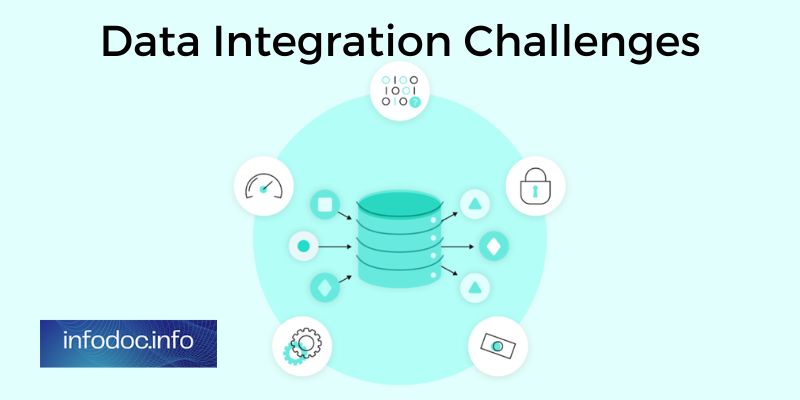In order for modern businesses to make data-driven decisions and get insightful information, data integration has become a critical component. The path to efficient data integration is paved with obstacles, many of which might be overwhelming. Infodoc will examine these data integration challenges in this article and provide you tips on how to solve them.
Contents
- 1 Understanding Data Integration Challenges
- 1.1 Strategy 1: Establishing a Robust Data Governance Framework
- 1.2 Strategy 2: Utilizing Data Integration Tools and Platforms
- 1.3 Strategy 3: Designing a Scalable and Flexible Data Architecture
- 1.4 Strategy 4: Collaborating Across Departments and Teams
- 1.5 Strategy 5: Addressing Data Security and Privacy Concerns
- 2 Conclusion
Understanding Data Integration Challenges
Data integration challenges encompass a wide range of issues that organizations encounter when attempting to bring together disparate data sources into a unified and coherent whole. These challenges can impede the flow of information, hinder decision-making processes, and limit the organization’s ability to harness the true potential of its data. Let’s explore some of the most common data integration challenges faced by businesses today.
Data quality and consistency issues are at the forefront of data integration challenges. When dealing with multiple data sources, inconsistencies in data formats, missing values, and varying data quality can arise. Such challenges can lead to skewed analyses and flawed insights, making it crucial to address these issues early on.
Another hurdle in data integration is the compatibility and format discrepancies between different data sources. Each system may have its own unique way of storing and structuring data, which can create complexities when attempting to merge them. Data integration tools and platforms play a crucial role in mitigating these challenges by providing mechanisms to transform and harmonize data formats.
Data security and privacy concerns pose yet another set of challenges in data integration. Organizations must ensure that sensitive data remains secure throughout the integration process, guarding against unauthorized access and data breaches. This becomes even more critical with the rise in data protection regulations, such as the General Data Protection Regulation (GDPR) and the California Consumer Privacy Act (CCPA).
Complex data mapping and transformation requirements are frequent obstacles in data integration initiatives. Mapping data from one format to another can be a laborious and error-prone task, especially when dealing with large volumes of data. Moreover, the need for data transformation arises when the target system expects data in a different structure or schema than the source system. These challenges often require a deep understanding of the data and careful consideration of business rules.
Legacy system integration poses a unique challenge for organizations with long-established systems. Older systems may lack the necessary interfaces and APIs for seamless integration with modern data platforms. Consequently, organizations must find innovative solutions to bridge the gap between legacy systems and modern data integration technologies.
To overcome these data integration challenges, organizations can employ a range of strategies and best practices. Let’s explore some of them:
Strategy 1: Establishing a Robust Data Governance Framework
Data governance plays a pivotal role in ensuring data quality, consistency, and compliance throughout the integration process. By defining data ownership, implementing data stewardship programs, and establishing data quality standards, organizations can tackle data integration challenges head-on.
Strategy 2: Utilizing Data Integration Tools and Platforms
Leveraging advanced data integration tools and platforms simplifies the process of extracting, transforming, and loading data from disparate sources. These tools offer automation and AI capabilities that can streamline data integration tasks and reduce human error.
Strategy 3: Designing a Scalable and Flexible Data Architecture
A well-designed data architecture forms the foundation for successful data integration. Organizations should consider implementing data lakes, data warehouses, and APIs to facilitate seamless data exchange between systems. Scalability and flexibility should be key considerations to accommodate future growth and changing business needs.
Strategy 4: Collaborating Across Departments and Teams
Overcoming data integration challenges requires collaboration and communication across different departments and teams. Breaking down data silos and fostering a data-driven culture can lead to improved collaboration and knowledge sharing, ultimately enhancing data integration efforts.
Strategy 5: Addressing Data Security and Privacy Concerns
Organizations must prioritize data security and privacy when integrating data from multiple sources. Implementing robust encryption protocols, access controls, and data protection measures are crucial in safeguarding sensitive information. Compliance with data protection regulations is essential to maintain trust with customers and avoid legal repercussions.
Conclusion
In navigating data integration challenges, organizations must adopt a proactive approach to address these issues effectively. By incorporating the aforementioned strategies, businesses can enhance their data integration processes and unlock the full potential of their data. However, it’s important to note that the journey towards successful data integration is an ongoing one, requiring continuous improvement and adaptation.
To ensure a successful data integration initiative, organizations should regularly assess their data integration processes and identify areas for improvement. By monitoring data quality, reviewing data governance policies, and seeking feedback from stakeholders, organizations can identify potential bottlenecks or emerging challenges and proactively address them.
Additionally, staying up-to-date with industry trends and advancements in data integration technologies is crucial. The data integration landscape is constantly evolving, with new tools and methodologies emerging to overcome existing challenges. Organizations should remain informed about the latest innovations and evaluate their applicability to their specific integration needs.
Furthermore, organizations can benefit from engaging with industry experts and seeking external assistance when needed. Consulting firms specializing in data integration can provide valuable insights, guidance, and implementation support. These experts can help navigate complex integration scenarios, offer best practices, and optimize data integration processes for maximum efficiency.
In conclusion, data integration challenges are a reality that organizations face in their quest for a unified view of their data. However, by demystifying these challenges and implementing the strategies outlined in this article, businesses can overcome the hurdles and unlock the power of their data. Establishing a robust data governance framework, leveraging data integration tools and platforms, designing a scalable architecture, fostering collaboration, and addressing data security concerns are key elements for successful data integration. Embracing these strategies and embracing a mindset of continuous improvement will empower organizations to harness the full potential of their data, making data integration a competitive advantage in today’s data-driven world.

















